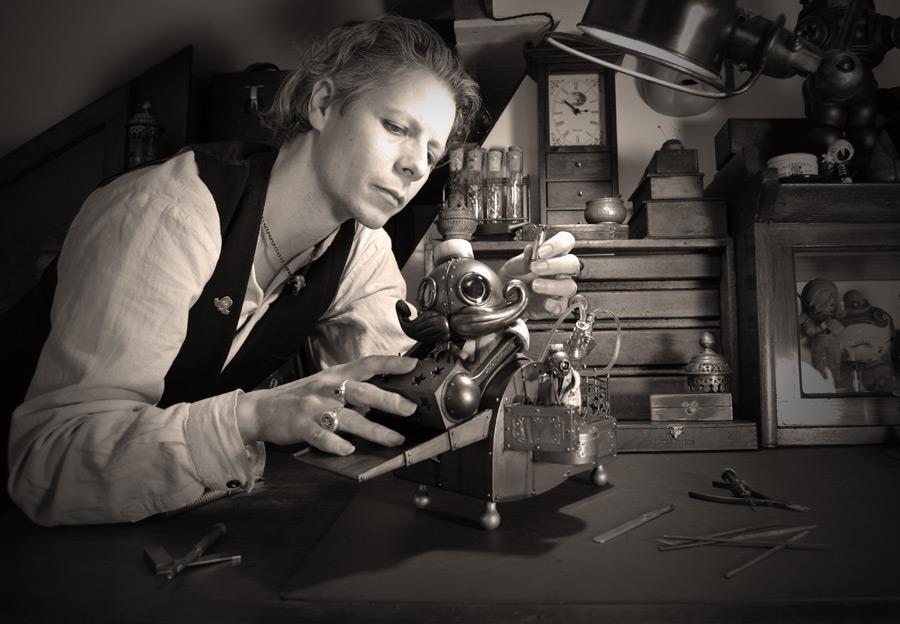One of the things that fascinates me is how, why and to what
extent people change the style they may have adopted for themselves. Of course
some Goths, once they have become such, stay exactly the same as they were at
18. Others move away from the subcultural world completely, once it’s fulfilled
whatever need it was that drove them there in the first place. Those who stay,
but change, I find most interesting.
 Now, many, many years ago I used to contribute to the Goth
magazine Meltdown with the odd
article or review. The editor had set it up to make her fortune, or at least her reputation, although I don’t think it really managed either in the few years it was going. Meltdown had an
in-house illustrator called Dr A who would come up with cartoons to accompany
articles for which no sufficiently appealing photograph could be found. Here’s
the one he did for my article on Gothic academic studies.
Now, many, many years ago I used to contribute to the Goth
magazine Meltdown with the odd
article or review. The editor had set it up to make her fortune, or at least her reputation, although I don’t think it really managed either in the few years it was going. Meltdown had an
in-house illustrator called Dr A who would come up with cartoons to accompany
articles for which no sufficiently appealing photograph could be found. Here’s
the one he did for my article on Gothic academic studies.
Dr A wasn’t just an illustrator. He also played synths with
a band who started out calling themselves Sneaky Bat Machine and then in the
very early 2000s morphed into Goteki. Goteki, or Sneaky Bat Machine, were
broadly speaking a Cybergoth band.
I’m pretty sure I’ve never listened to any of their output, but feel fairly
confident that it would have been the kind of thing that makes more traditional
Goths quiver with rage. ‘Sounds like an ‘80s computer game soundtrack’,
commented IF magazine of their album,
apparently. You don’t see many Cybergoths these days – you don’t see many Goths
at all, of course, but Cybers are a near-invisible minority even within the
subculture now, though once upon a time, in the late 90s and early 2000s, there
were loads of them. Cybergoths mingled regulation black with fluorescent tubing
hair extensions, enormous furry boots, and, ubiquitously, little black goggles
perched high on the arrangement of multicoloured dreadlocks and plastic that
served them for a hairstyle. So Dr A was one of these fellows. Here’s a picture
of the band from their Goteki phase, from their one-time record label Wasp Factory: he’s the one on the left.
I had not spared any of this a thought for years. Then not
long ago while looking for something else entirely I stumbled across an artist
and sculptor/toymaker calling himself Doktor A. This Doctor constructs little Steampunkish characters from a strange
fantasy world called Mechtorians, all of which have their own identities,
histories, and, quite often, riveted brass moustaches. He exhibits them all
over the place and sometimes people buy them. It was while looking at some of
his drawings that I noticed affinities, little features, that reminded me of
the cartoons of the other Dr A all
those years ago. There were spirals –
and you might say with some justice that attenuated spiral motifs pop up in all
sorts of Gothic artistic places thanks to Tim Burton and The Nightmare Before Christmas – but they still leapt to my
attention. And, buried away in the depths of Doktor A’s website there are
little resin caricatures of the members of Sneaky Bat Machine, which can be
yours for a mere £150. The Doctor and the Doktor are one and the same, even if
the resemblance may be hard to glimpse in photographs.
But Dr A has eschewed his fluorescent tubes and gigantic
boots in favour of a granddad shirt and a waistcoat. This is what he looks like
nowadays, as depicted by circusposterus.com. His ‘artist’s biography’ somewhat unhelpfully informs the online enquirer
that ‘raised by the military and monitored by men in white coats until he was
16, Doktor A has always scribbled monsters’, giving no clue as to the nature
and causes of the artist’s shift over the last dozen years from Cybergoth to
Steampunk. It’s a move from a style based on a fantasised vision of the future
to one organised around a fantastic vision of the past – in which the only
continuity is provided by goggles, except that now they’re brass and leather
whereas once they were plastic. But they’re both outsider style, linked by a
dissatisfaction with the aesthetics of the present and a determination to dress
up. That’s the connection, I suppose.



I like it. You still do see the odd Cyber out and about but their natural environment is either at Slimes or at a festival. I have a view that the change is age related. You are right about the outsider aesthetic but steampunk offers a more genteel retirement compared to the frantic rave driven industrial beats of cybergoth (or, indeed, cyberpunk as it was initially).
ReplyDeleteI think you're right about aging and have said much the same myself. There are some strands of Gothic that you simply can't keep going with indefinitely and maintain any degree of dignity, while remaining in touch with your inner Victorian engineer, explorer or daring aeronaut can keep a chap going until well into middle age. Glad you like it - and hope Dr A will do so if he should stumble across it!
ReplyDelete